Achaemenid Art List of Hollywood Historical Movies About Iran
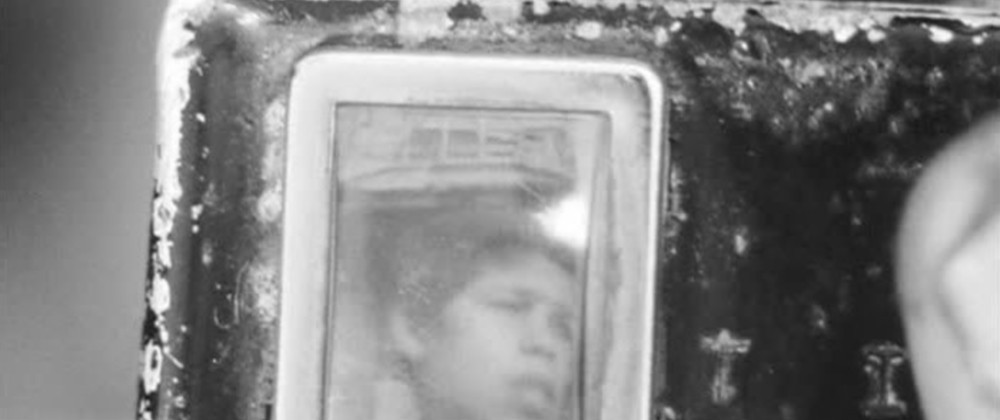

In recent years, post-revolutionary Iranian movie house has been praised in many international forums. What has attracted international audiences to this national cinema is its distinct style, themes, authors, thought of nationhood, and manifestation of culture. In this essay, I will contextualize the emergence of this new cinema past providing a cursory historical background of Iranian national cinema, with an emphasis on the foundations of filmic art in that region.
If one were to trace the kickoff visual representations in Iranian history, the bas-reliefs in Persepolis (c.500 B. C) would exist one of the earliest examples. Persepolis was the ritual center of the ancient kingdom of Achaemenids. Every bit Honour and Fleming [1] country, "the figures at Persepolis remain spring past the rules of grammar and syntax of visual language[.]" This way of visual representation reached its high meridian about a thousand years later during the Sassanian reign. A bas-relief in Taq-eastward-Bostan (western Iran) depicts a complex hunting scene. Movements and actions are articulated in a sophisticated manner. Nosotros can even run into the progenitor of the movie house close-up: a wounded wild squealer escaping from the hunting ground (Omid, p.19). After the Arab invasion and conversion from Zoroastrianism to Islam —a religion in which visual symbols were avoided — Persian art continued its visual practices. Persian miniatures are great examples of such attempts. The deliberate lack of perspective enabled the artist to have dissimilar plots and sub-plots within the same space of the picture.
A very popular form of such art was Pardeh-Khani. Similar to the Benshi of silent Japanese movie theatre, a Pardeh-khan (narrator) would uncover the painting as the story progressed. Another type of fine art in the same category was Nagali. A Nagal (or storyteller) would do an entertaining performance commonly in Ghahve-khanes (coffeehouses), which were the chief forums for cultural interactions between people. As a performing artist, Nagal had to possess a skilful oratorical and singing voice too every bit theatrical talent. Above all, the Nagal relied on his imagination a great deal, to improvise according to the audition'south feedback and add to the original tales that he was reciting. He would also acquire inspiration from the images and pictures stock-still on the walls – pictures of religious leaders, sport heroes, epic characters – and appropriate them into his narrative. The dominant themes in Nagali were epics depicted from Shah name [ii] or the story of Alexander's quest for the elixir of life.
It is worth mentioning that in that location were many other dramatic performance arts that were popular before the advent of cinema in Iran. Khaymeshab-bazi (puppet show), Saye-bazi (shadow plays), Rouhozi (comical acts), and Ta'zieh (a form of Persian passion play, presentation of tragic dramas based on the martyrdom of Hossein, an extremely of import figure in Shi'asm) are just a few examples. [3]
With respect to Iranian perception of imagery, 1 should exist aware of the long tradition in verse. From Yashts (the ancient Western farsi Hymns) to post-Islamic Sufi poesy, equally well as gimmicky Iranian poetry, we can find numerous examples of this fine art of paradigm making. The improvident utilise of symbolism and juxtaposition of codes and symbols gives Persian poetry a unique visual sense. [iv]
Cinema Reaches Iranian Soil
It was on August 18, 1900 that the beginning Iranian photographer recorded images of life on celluloid. Mirza Ebrahim Khan Akkas Bashi was the official photographer of Mozaffar al-Din Shah's court, who accompanied the monarch in his offset visit to Europe. He was introduced to the "cinematographe" in France while they stayed in Paris in July of the same twelvemonth to see the Exposition. On the aforementioned day of the Exposition, the Shah ordered Akkas Bashi to purchase all equipment necessary for recording and displaying the motility picture in his court. Akkas Bashi took his first images in Belgium while they attended the Festival of Flowers. These images are possibly the outset ethnographic footage taken in the history of Iranian picture palace, even though its master purpose was documenting the Shah'south visit to Europe.
As nosotros can see, film was brought to Iran by the Rex as a tool of entertainment for members of the monarchy and the purple courtroom. After seeing the first flick of his life, Mozaffar al-Din Shah writes in his travelogue diary:
"….[A]t 9:00 P.Grand. nosotros went to the Exposition and the Festival Hall where they were showing cinematographe, which consists of still and move pictures. And so we went to Illusion building ….In this Hall they were showing cinematographe. They erected a very large screen in the centre of the Hall, turned off all electric lights and projected the picture of cinematography on that large screen. It was very interesting to picket. Amid the pictures were Africans and Arabians traveling with camels in the African desert which was very interesting. Other pictures were of the Exposition , the moving street, the Seine River and ships crossing the river, people pond and playing in the water and many others which were all very interesting. Nosotros instructed Akkas Bashi to buy all kinds of it [cinematographic equipment]and bring to Tehran so God willing he can brand some there and show them to our servants." [5]
Unlike many other places in the globe, where picture palace equally marketable commodity was used equally mass-entertainment medium [6], in Iran cinema circled among courtly nobles and the Royal family (like in Nihon). Cinematography had to be presented on occasions such as weddings and circumcisions or other festivities in aristocratic settings, usually projected along with French one-act shorts that were imported through Russia.
The first public screening took place in Tehran in 1904, presented past Mirza Ebrahim Khan Sahaf Bashi. He bundled the screening in the back of his antique store. In 1905, Sahaf Bashi opened the kickoff film theater in Cheragh Gaz Avenue in the national capital. There were no chairs in the Saloon and audiences had to sit on the carpeted floor, every bit they would sit in mosques or at Ta'zieh shows. Sahaf Bashi'southward movie theater did not last for more than a month, considering of his political activities as a nationalist and an individual who was lobbying for a ramble monarchy. Too, religious opposition provided the Shah'south police with a sufficient excuse to arrest Sahaf Bashi, close down the cinema and confiscate his projector and related equipment. He was before long sent into exile. Mayhap this was the first instance of censorship in the history of Iranian movie theatre.(Omid, p.870).
Two years subsequently, a few Russian and Armenian immigrants individually tried to establish new motion-picture show theaters in Tehran. Russi Khan was the most successful figure amidst these new cinema owners. With the connections that he held in the Royal courtroom, he could expand his business despite religious contentions. The presence of the Russian Regular army in the north and Tehran was some other support for Russi Khan, since they shared the same nationality and provided an additional market for his enterprise. In 1909, with autumn of the Mohammad Ali Shah (heir of Mozaffar al-Din Shah) and the success of the constitutionalists, Russi Khan lost his support. Consequently, his pic theatre and photography studios were destroyed by the public. Soon after, other movie house theatres in Tehran airtight down.
Movie theatres sprang up again in 1912 with the help of Ardeshir Khan (an Armenian -Iranian). Ghafary, a pic historian in Iran, believes it was Ardeshir Khan who fashioned movie theater operation as an organized business. The existence of such an infrastructure encouraged other Iranians to open up new movie theaters (Issari. p. 61). Another important person in this era was Ali Vakili, who established a few flick houses and a publication on evidence concern in the late 1920s. Until the early 1930's in that location were little more than xv theatres in Tehran and eleven in other provinces. By 1978 these numbers grew to a 109 in the national capital and 318 in various Iranian cities. [7]
Pioneers of Iranian Cinema
After Akkas Bashi, photographer for Mozafar al'Din shah, and Russi Khan, who was too hired by the Royal family unit to film court activities, Khan-baba Khan Mo'tazedi was the third Iranian person involved with cinematography. As an technology student living in Paris, Mo'tazedi institute piece of work in a picture show company. This enabled him to learned how to operate a motion picture photographic camera and how to process film. With his return to Iran in 1916 Mo'tazedi brought some moving-picture show equipment (films, camera, projector and processing material). What began equally a hobby eventually became his profession.
Mo'tazedi likewise became a court photographer. He shot a considerable corporeality of newsreel footage during the reign of Qajar to the Pahlavi dynasty. [viii] Mo'tazedi is also credited for being the first person to have bundled a public screening exclusively for women earlier 1920. From the tardily 1920'southward on, Mo'tazedi worked in the Iranian picture show industry and became one of the major cinema owners of the time. He was also the first to add together Farsi inter-titles to strange films.
In 1925 a young Armenian-Iranian, Ovanes Ohanian (Oganianse), a Russian national who studied film in Picture palace Akademi Of Moscow, returned to Iran. His goal was to found a film industry in the country. Since he constitute it impossible to initiate whatsoever production without professionals in the field, Ohanian decided to brainstorm a film school in Tehran. Within five years he managed to run the commencement session of the school under the name: "Parvareshgahe Artistiye movie theatre" (The Cinema Artist Educational Centre). [9] Acting and performance, rather than film production, were the cornerstones of the institution.
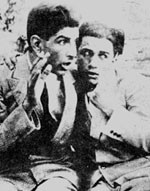
After v months, with a few of his graduates and the financial help of a theatre owner, Ohanian directed his first Iranian film, Abi va Rabi, (1929). The film, lensed past Mo'tazedi, was shot silent on 35mm black and white stock and ran 1,400 meters long. [ten] As Ghafari states: "This flick was patterned directly subsequently the comic acts of the Danish cinema couple Pat and Paterson. Iranians had seen [films of] this couple many times in the cinemas and liked them." [11] Abi va Rabi was received well by critics and the public. Unfortunately the only copy of the moving picture burnt to ashes two years after its release in a burn accident in cinema Mayak, i of the first theatres in Tehran.
By the end of the schoolhouse's second session, Ohanian started his next project, another comedy entitled Haji Agha Aktor-e-Movie house (Haji Agha the Movie theatre Actor, 1933). The film was a reflexive structure (as appears in its title) near a traditionalist who is suspicious of movie theater, but by the end of story recognizes the significance of flick art. Haji Agha Aktor-e-Movie house did non do well at the box office. Not only were there technical shortcomings, but additionally, the release of the first Persian talkie (produced in Republic of india) macerated its prospects for profit. Later on the failure of his second flick, Ohanian could not find any support for further activities. He left Islamic republic of iran for India and connected his academic career in Calcutta. Subsequently he returned to Iran in 1947, where he died seven years later.
The 2nd Iranian director of that same era was Ebrahim Moradi. Equally a member of a guerrilla movement (Gangal) in the North of Iran during the late 1920's, the young Moradi sought asylum in the Soviet Union with his male parent. Moradi lived in Russian federation for a few years, where he was introduced to the technical aspects of film. In 1929 he established his own movie studio called Jahan Nama in a port city by the Caspian body of water, Bandar Anzali. Moradi started shooting his first film Entegham-e-Baradar (A Brother'southward Revenge) nigh a year subsequently. By 1931, 1700 meters of movie was edited but he had no coin left for completing his project.
Privy to some information of cinematic activities in the National Capital letter, Moradi moved to Tehran in search of financial help. Yet the young director never completed his first film. In a few months, however, he started a new project, Bolhavas (The Lustful Homo) a melodrama released in 1934. This silent film, which received good reviews, was the terminal Iranian feature product washed within its borders until the end of the 2nd World War.
Sepenta
Abdul Hossein Sepenta, the male parent of Persian talkies, was built-in in Tehran in 1907. As a young writer and poet, Sepenta went to Republic of india in the mid-1920s to report ancient Western farsi language and history. In Mumbai, his friendship with professor Bahram Gour Aneklesaria (an practiced in one-time Iranian languages) encouraged him to consider the new and developing medium of picture show. Through his adviser Dinshah Irani, Sepenta met Ardeshir Irani, another elite of the Bombay Parsi community. Irani was the executive director of Majestic Film, and agreed to invest in Sepenta's first Farsi talkie. Sepenta began educating himself about the film medium.
He met with Debaki Bose, a pioneer of Bengali cinema who was also interested in representing his culture in a new, epic form. Subsequently an introduction to the theory of film, Sepenta started writing his script, with Ardeshir Irani as technical supervisor. Irani also co-directed the motion picture. Dokhtar-e-Lor (The Lor Daughter) [12], the beginning Persian talkie to be released, is the product of this interaction. The pic was an absolute success and stayed on Iranian screens for more than 2 years. Imperial film was then impressed by the success of the talkie that they offered Sepenta production control over another film. Sepenta made iv more films for Imperial Motion-picture show: Ferdousi (1934), Shireen va Farhad (1934), Cheshmhaye Siah (Blackness Optics) (1935) and Leyla va Majnun (1936). Interestingly, he also made i film for the Due east India Moving picture Company in Calcutta. All of his films dealt with the glorification of the one-time Iranian culture or the optimistic futurity of a modern Islamic republic of iran.

Sepenta returned to Iran in 1936 with the hope of establishing a film company with the help of government and private sector funding. Unfortunately, he failed to mobilize any support from either party. Due to his mother's sickness and his financial situation Sepenta was forced to stay in Iran. To support his family he started working in a wool manufactory in Isfahan. Sepenta remained productive, publishing eighteen books and five films, and, every bit chief editor of two magazines, writing many articles on art and culture. At the historic period of 62, iii years before his expiry in 1968, Sepenta tried his manus at picture show once again. But this time in a manner far from the epic course of his earlier work. With a uncomplicated 8mm camera Sepenta recorded the everyday reality around -footage which was has never been released for public screening.
Years of Absence
The period of 1937 to 1948 marked a decade of non-productivity in the history of Iranian national cinema. One can find many reasons for these years of cinema hibernation. The almost obvious causes are: Iran's general political crisis generated by the Second World War; the country'due south occupation by allies; the undermining of the movie theatre manufacture by the establishment; and, of course, the domination of foreign films (especially Hollywood).
Reza Shah, the kickoff monarch of the Pahlavi dynasty, came to power in the early 1920s. Despite his fascination with modernisation and technology, the Shah could not empathise the importance of a moving-picture show manufacture. The just contributions to movie theatre he made were the 500 Toman awarded to Mo'tazedi for his newsreel based on the Shah's coronation.
After existence impressed by a Mo'tazedi's newsreel documenting the installation of an Anglo-Persian oil company in Khusestan, the Shah ordered the construction of a new movie theater in Tehran. The industrial sights of his country on celluloid overwhelmed the Shah. Every bit Mo'tazedi remembers, the Shah remarked: "Marvelous! How well washed! What mod installations! Just alas they [British oil company] give Iran little money…." Right after the screening, the Shah ordered the police chief to start building a movie theater in the poor function of town. The name of the theatre was Tammadon (civilization!). [13] This was the most generous contribution fabricated to Iran's moving picture manufacture by Reza Shah's regime.
Reza Shah's superficial delineation of culture and modernity brought many Western values to Iranian society. For instance, he banned the chador for women, dictated a Westernized dress code for men, and forbade Iranian passion plays. Because of their long history of colonial interest in Iran, the Shah thought the British and Russians untrustworthy. Then he turned to Germany for professional and technological knowledge. By the end of the 1930s there were about 400 German language skilled labourers working in seven German language based companies in Iran.
During World War Two, the Allies establish Iran to exist a disquisitional strategic zone for supplying Russians with military hardware. In spite of Iran's announcement of neutrality, the Allies demanded the deportation of German citizens from Iran. Due to negative responses from Reza Shah, Iran was invaded by the British (in the South Due west) and the Russians (from the North) on August 25, 1941. With American troops entering in October of the same twelvemonth, Iran, equally 'The Bridge of Victory', suffered the woes of occupation by 3 Western powers. Reza Shah was sent to exile past the British and was replaced by his son in September 1941.
Both the physical existence of Western powers and the cultural domination by Allies, made imperialism e'er-present in the media. For propaganda purposes more movie theatre theatres were opened to show dubbed newsreels and expository documentaries. Hollywood productions dominated the screens and left no space for whatsoever local cultural activities. [xiv] Dubbing was one of the few means of participation for Iranians in the motion picture industry during this era.
Since a large percentage of Iran's population was illiterate, they were incapable of reading the explanatory inter titles, and many were unfamiliar with European languages. Dubbing was the ideal solution for distributors and cinema owners to gain further profit. For this purpose, many dubbing studios were establish betwixt 1943 and 1965. The demand for the development of dubbing systems in Iran resulted in many local exports in the field of sound reproduction. But it too had its side furnishings, most notably that of slowing downwardly the development of sync sound recording on the set for future activities. [15]
Another Nativity
In 1947 Esmail Kooshan, an economist with a secondary degree in communications from the Univerum Film Aktiengesellschaft (UFA), returned to Islamic republic of iran. [16] On his fashion from Berlin he bought 2 European films which he dubbed in Persian in a studio in Istanbul. The commercial success of these 2 films increased his business of the local motion picture industry. Shortly Kooshan established Mitra Picture with the association of a few relatives and friends. The starting time feature production of the Studio was Toofan-east-Zendegi (1948) (Storm of Life), a critical social drama directed by Ali Daryabegi, a theatre director/actor who had no experience in filming. The moving-picture show was a total failure at the box office and received no praise from critics.
Despite withdrawal of a few partners from the company, Kooshan did not surrender and made his 2nd film in the same twelvemonth. This time Kooshan photographed and directed the moving-picture show himself. Zendani-e-Amir (Amir's Prisoner) had a relatively better rate of success, which encouraged Kooshan to go along in his career equally filmmaker. Finally, after another disappointing mail service-production response from Varieteh Bahar (The Spring Festival, 1949), Kooshan made his basis breaking film, Sharmsar (Ashamed, released in 1950). Sharmsar was produced under the name of Kooshan's new visitor, Pars Flick. This romantic musical with a adult female as the main grapheme depicts the story of a village girl who ends upwards in the urban center subsequently beingness seduced by an urban man. But presently she recovers from her shock and employs her talents to accomplish fame and fortune, and so returns to her village. The lead character of the flick was Dilkesh, a popular vocalist of the time. Indeed it was her presence which guaranteed the financial success of the film.
Meanwhile, other Iranians in the private sector, tempted to test their luck in the film business, stepped into the picture. Mohsen Badie produced the adjacent blockbuster in the history of Iranian cinema: Velgard (Vagabond) past Mehdi Rais Firuz. This film, released in 1952, is a melodrama with moralistic overtones, accompanied by songs and suspenseful action. Issari suggests: "Information technology was the combined box part success of Sharmsar and Velgard, […], that gave the Persian [Iranian] pic industry a shot in arm and saved it from extinction." [17]
The movie that actually additional the economy of Iranian movie theatre and initiated a new genre was Ganj-e-Qarun (Croesus Treasure), fabricated in 1965 by Siamak Yasami. Yasami had worked with Kooshan prior to establishing his ain company; Porya Film, in 1960. A huge fiscal success, Ganj-e-Qarun grossed over lxx one thousand thousand Rials (one million dollars). The theme of the film concerns the worthless and desperate life of the upper center class in contrast with the poor and happy working class, which is 'rich' in morals.
Iv years afterwards Masud Kimiaie made Qeysar, an award winning moving-picture show at the 1969 Tehran Film Festival. With Qeysar, Kimiaie depicted the ideals and morals of the romanticised poor working class of the Ganj-e-Qarun genre through his master protagonist, the titular Qeysar. But Kimiaie's film generated some other genre in Iranian popular cinema: the tragic action drama.
From 1950 to the mid-1960's the Iranian film industry grew rapidly. Many studios were established every bit well equally others that entered the cycle of the film industry independently. At that place were 324 films produced during this period (1950-1965). By 1965 there were 72 moving-picture show theatres in Tehran and 192 in other provinces.
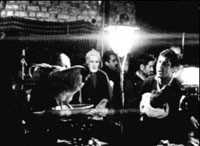
The foundation of that new-born cinema was capitalism. Information technology was saturated with dominant themes of dance, music, simplistic dramas and Persianized versions of Western popular movies. But it also brought about the possibility of an independent national cinema. One of the commencement efforts for such cinema was Farokh Ghafari'due south Shab-e-Ghouzi (The Nighttime of Hunchback, 1964). Filmed in a magic-realist form and based on a story from 1 Thousand and One Nights, Shab-east-Ghouzi was the first feature film selected for international festivals. The other notable flick in this category is Khesht va Aiene (Mudbrick and Mirror, 1965), produced and directed by Ebrahim Goulestan, the owner of Goulestan studio. Goulestan created an culling surround out of which sprung several outstanding documentaries throughout its operation until 1978. One of the all-time known product of Goulestan Studio is Khaneh Siah Ast (The Firm Is Blackness, 1963), a documentary written and directed past Forugh Farrokhzad, a leading poetess in contemporary Persian literature. This motion picture was selected every bit the best documentary in the 1963 Oberhausen Picture show Festival.
By 1970 Iranian cinema entered into its mature stage. The College of Dramatic Arts, instituted in 1963, produced its offset graduates at the decade's start. Many progressive motion picture co-ops and associations came into existence; and there were a few regular film festivals taking place in the country.
Young Iranians showed a corking interest in avant-garde forms of movie house, which reflected their activities. One of the best known of such efforts was Cinemay-e-Azad (Gratuitous Movie theater). The collective was formed by a grouping of cinema students and interested individuals in the mid-1970s. They started to screen experimental and short 8mm films by their members and soon supported and participated in each other's projects. This movement spread around the state and in a curt time they had their own national festival. The Ministry building of Civilisation and Fine art also organised similar associations nether the proper noun of Anjoman-e-Cinemay-due east-Javan (The Young Cinema Association) with collaborations by National Television set.
One of the near important system which was (and still is) a great assist to evolution of national cinema is The Institution for Intellectual Development of Children and Young Adults. The institution was founded by Lili Jahan Ara, a close friend of Farah Diba (The Queen). With the support of Farah Diba, a library became the beginning projection of the Institution. And in 1969 it started its picture palace department. Soon many immature talented filmmakers and animators joined the organisation. The main attraction of the institution was its title, which could provide the artists relatively greater freedom of expression than elsewhere. Many prominent directors of Iranian national cinema started their careers there or made films for the institution. Amidst them are: Bahram Baizai, Amir Naderi, Abbas Kiarostami, Reza Alamzadeh and Sohrab Shahid-Sales.
The 1970s was a special decade for Iranian cinema. Equally Goulmakani states: "the seventies saw the meridian of the Shah'southward conviction in his social and political successes. Deluding itself into believing that it had grown unassailably stable, the authorities now allowed the making of a few films with critical social themes." [18]
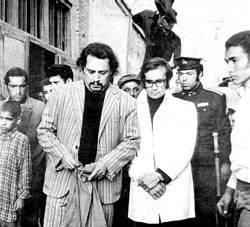
Many important filmmakers emerged from the pre-revolution era. Including Parvis Kimiavi, who made the reflexive masterpiece Mogholha (Mongols, 1973), a film which allegorizes the cultural imperialism of Television past comparison that situation to the invasion of Mongols. Bahram Baizai is the director of one of the ground-breaking films of the Iranian New wave, 1972's Ragbar (Downpour). Sohrab Shahid-Sales is an auteur managing director who embodied his original way in his 1975 film Tabiat-e-Bijan (Spiritless Nature). Abbas Kiarostami is now a well known director of the 1990's who directed one of the last films that screened before the revolution in 1978, Gozaresh (The Report). Dariush Mehrjui, a UCLA Cinema and Philosophy graduate, directed Gav (Cow) in 1969 and the controversial Dayerehy-due east-Mina (Mina Cycle, 1975), which was banned for iii years. The latter'due south subject affair dealt with people involved in the claret business. Interestingly, the flick was only banned until the government opened its start blood bank.
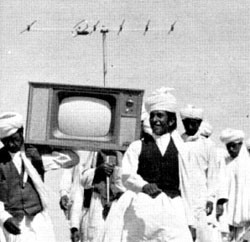
Mongols
The new cultural, political and economical environment from mid-sixties to late seventies created a unique national cinema that had roots in Iranian perspectives of art, literature and culture. The mainstream commercial movie theatre in the 1970s encountered an innovative form of movie theater. The counter picture palace was a political cinema that developed its symbolic language due to a long history of censorship. This "Third" cinema was very different from that existing in Latin America, Africa or whatsoever developing countries, because of different social-historical contexts. Some of the filmmakers of that period were forced to get out the country for political and cultural circumstances. Those who stayed challenged the new way of religious and moral censorship of art and culture. It should too be noted that the bonny Iranian cinema of today is the outcome of a tradition developed in the pre-revolution era.
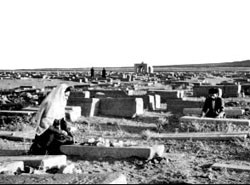
Endnotes
1. Award, Hugh and John Fleming, The Visual Arts: A History. New Jersey, Prentice Hall Inc, 1992. Page: 96.
2. Shah name or Book of kings a vast epic based on pre-Islamic history and mythology past poet Ferdausi (10century A.D) in verse form.
3. A great introduction on art and in amusement in Islamic republic of iran before the advent of cinema is provided in M. Ali Issari book: Cinema in Islamic republic of iran: 1900-1979 pages 40 -67.
4. This exert from a long verse form tin can be a skillful example of such visualization, written by Sufi poet Maulana Jalaluddin Rumi 13 century A.D)
Am I at present I am as liquid
wine on fire
turned vaporizing
to fire at the touch of your oral fissure
blazing even on the glass that holds me….
in your cup?
You have not asked me he
-this I know.
No door have you opened to me.
Information technology seems
I accept been poured
into your vino drinking glass
as past accident
or as one small piece
of some catholic joke.
In the heat
of your jiff
I have become
nothing that I know.
- From the volume In Praise of Rumi by Ryan, R.S. Prescott, Homhm Press, 1989 page 6.
5. The translation of the travelogue in Issari's book: Movie theatre in Iran: 1900-1979 pages 58-59
half-dozen. Roy Armes, Third World Film Making and the Due west. p. 55.
vii. Related figures are in Mehrabi's volume The History of Iranian Movie theatre. page:482 & 489.
8. Mo'tazedia besides made one of the first fiction(a short comedy)in iii reels. But in that location is no record or description of this motion picture in available sources on Iranian moving-picture show history the only mentioning of this film is in M.A Issari's book Cinema in Iran, page:96.
9. Government does not permit 'school' equally role of the title considering cinema and pic is not nevertheless considered as a serious subject to exist studied at schoolhouse.Omid.page:42.
10. Omid page:44.
11. Ghafary in Issari page:97.
12. The title of the movie before its first showing in Tehran changed to Dokhtar-e-Lor ya Irane Diruz va Emruz (The Lor Daughter or Islamic republic of iran of Yesterday and Today.
13. Issari.folio:94-95.
fourteen. Omid. page: 102-105. Issai. folio:119-120.
fifteen. Omid, pages:926-930
16. Omid,page:926-927
17. Issari, page:136.
xviii. Golmakani in "New Times New Perceptions," page:22.
Bibliography
Allamehzadeh, Reza. AZ Bleak BAAR ATASH. ( From Distance on Burn down.) Toronto: Afra, 1995. 127pgs. (Persian) >
Cheshire, Godfrey. "Where Iranian Cinema Is" in Film Annotate , v.29, March-Apr 1993, p. 38.
Goulmakani, Houshang. "New Times, New Perceptions" in Cinemaya, No.iv, Summer 1989, p22.
___________________. "No Trivia No Masterpieces" in Cinemaya, No.3, Leap 1989, p 18.
___________________. "Iranian Women Directors" in Cinemaya No.3, Spring 1989. p 26.
Issari, Grand. Ali. CINEMA IN IRAN 1900-1979. Metuchen: The Scarecrow Press, 1989, 446 pages. (English)
Maghsoudlou, Bahman. IRANIAN CINEMA. New York: New York University, 1987. (English language)
Mehrabi, Massoud. THE HISTORY OF IRANIAN Movie theatre. Tehran: Film Publication, 1988, 602pgs. ( Persian)
Nayeri, Farah. " Iranian Cinema: What Happened in Between." in Sight and Sound, v3, December 1993, p.26.
Omid, Jamal. THE HISTORY OF IRANIAN Movie theater 1900-1978. Tehran: Rozaneh Publication, 1995, 1174 pgs (Persian).
Source: https://offscreen.com/view/iran2
Postar um comentário for "Achaemenid Art List of Hollywood Historical Movies About Iran"